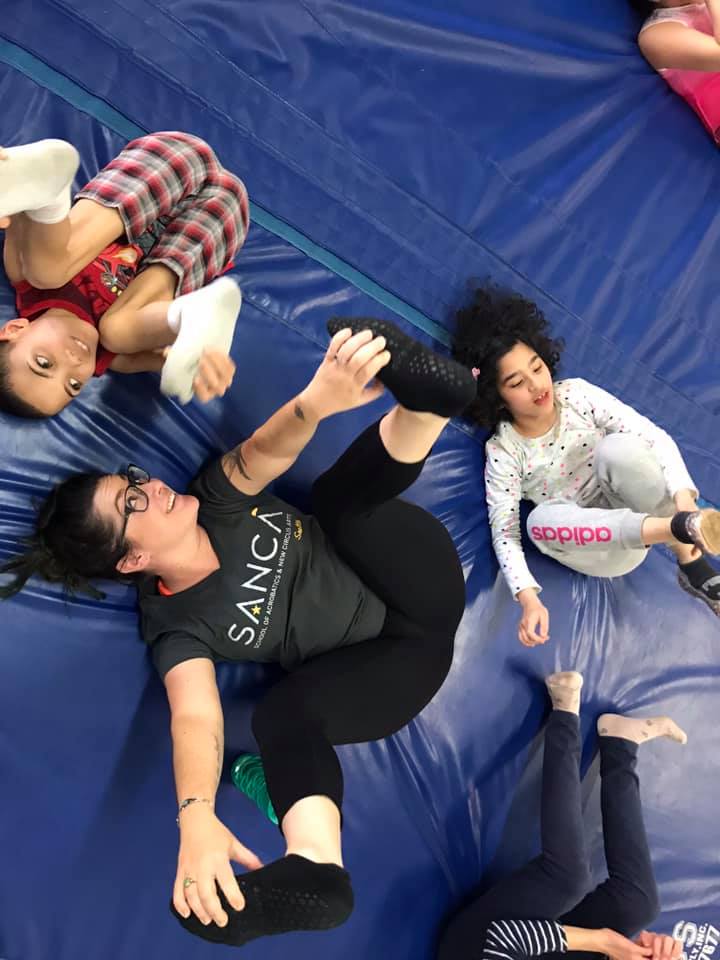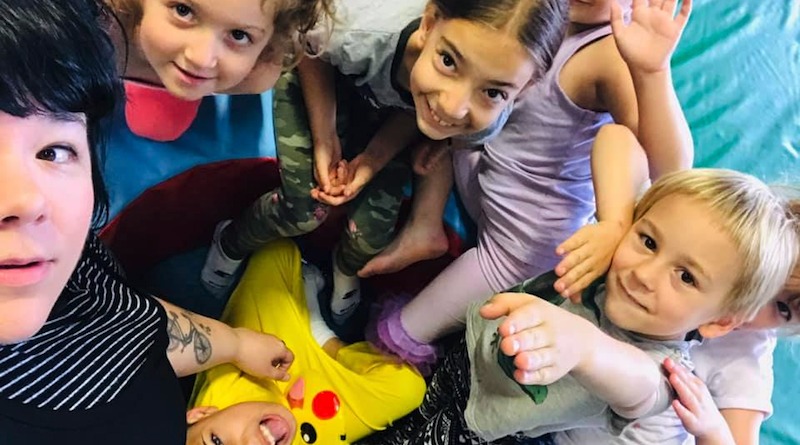“Being With” — How to Enhance Relationships with Your Circus Students
At The School of Acrobatics and New Circus Arts (SANCA), where I am the Director of Social Circus, we seek to improve the quality of life for the people we serve, particularly children, using circus arts as a catalyst for positive change and personal growth. In my work outside of SANCA, I am a play therapist. Play therapy has given me tools for facilitating relationships with children that I regularly bring into my work at SANCA, as building strong, safe relationships helps us fulfill our mission of changing children’s lives and supporting their growth. I find these tools invaluable at the circus, where we are serving hundreds of children each week. In play therapy we communicate to children, “I am here, I understand, I hear you, I care.” We call this “Being With”.
Being With: Skills for Effective Relating
 Regularly, I am asked to consult on behavioral issues coaches encounter in the process of teaching circus arts. We are often looking for shortcuts to getting kids to “behave”, but we find those shortcuts don’t work. The most powerful tool we have for addressing behavioral issues is a strong relationship, and that takes time to cultivate. The process of building a relationship with a child can be confusing and frustrating because children are not small adults; they do not think, feel, or relate like adults do. Thus, it is our task as circus arts educators to figure out how to meet kids on their level. Here are some tools you can use to help you facilitate that relationship-building process.
Regularly, I am asked to consult on behavioral issues coaches encounter in the process of teaching circus arts. We are often looking for shortcuts to getting kids to “behave”, but we find those shortcuts don’t work. The most powerful tool we have for addressing behavioral issues is a strong relationship, and that takes time to cultivate. The process of building a relationship with a child can be confusing and frustrating because children are not small adults; they do not think, feel, or relate like adults do. Thus, it is our task as circus arts educators to figure out how to meet kids on their level. Here are some tools you can use to help you facilitate that relationship-building process.
Tool #1: Connect Before Direct
Approaching children with curiosity, and learning about who they are, what they think, and how they feel, will foster connection and relationship building between you and your students. You will learn about their needs and they will learn that their coach cares about them. Before you begin instruction each week, take a few minutes to check-in. If they were a color, what color would they be? How about an animal? What are they worried about today? What are they excited to try? Making this intentional space for children to express their thoughts and feelings enrolls them as active participants in their learning and gives them a sense of power that will support positive behaviors, as many unwanted childhood behaviors are born out of a sense of powerlessness. Children seek power and autonomy, which is healthy and adaptive for them to do. When power is not given to them, children will find other ways to take power back, such as antagonizing their peers, refusing to participate, or not staying with the group. By connecting before we direct them in circus activities, we honor this need for power and autonomy in a way that keeps the class on track, and keeps us in the driver’s seat as instructors.
Tool #2: Understand Their Brains
If we are to build relationships with kids, it’s helpful to learn how their brains work. Learning about the child brain will not only help you relate effectively during moments of distress, integrating this understanding into the way you teach will prevent distress from happening. To really dig into the neurobiology of the brain is a big job; there is so much you can learn that will support your practice as a circus arts educator. What is described here is by no means exhaustive. However, a great first step to building this knowledge base is understanding that we have different parts of our brain that house different aspects of who we are. We have logical parts, emotional parts, and primal parts of our brain and those parts work together, or don’t work together, depending on what we are experiencing around us. Our midbrain is where our feelings live, above it is our prefrontal cortex, where our logic lives. When our emotional midbrains are overactive, these brain-neighbors disconnect, and the logical prefrontal cortex goes offline. Dr. Dan Siegel, a popular author, theorist, and lecturer on the topic of neurobiology, calls this, “Flipping Our Lid”. Both children and adults flip their lids, but because children’s brains are still developing, they flip their lids more often. Children can flip their lid because they are tired, hungry, afraid, overwhelmed, sad, overstimulated, or anxious. By understanding that when the emotional part of the brain is over-functioning the logical part of the brain is under-functioning, we gain insight into why telling someone to calm down does not help them calm down. That is not a message our logical brain can hear when our emotional brain is in distress- it’s not that the child won’t listen, it’s that the child can’t listen. Reasoning with a child who has flipped their lid is not only ineffective, but that kind of response to behavior could potentially escalate the situation.
Tool #3: Validate instead of React
So, how do we appeal to the emotional brain? How can we get the logical brain back online so we can continue teaching circus arts? We can do this by validating their experience. By hearing a child’s experience and reflecting their feelings, they feel understood. We all feel calmer when we feel seen and heard, don’t we?
Here’s a scenario to illustrate the difference between reacting and validating in a circus classroom:

You are moving your class in a line from one area to another, and a 6-year-old student trips and falls down. The student was frightened by the fall and the impact hurt, but they were not injured. They sit on the floor and begin to cry. You cannot move the group forward to the next activity so you have to respond to the child.
A reactive response: “Don’t cry, you’re fine. You didn’t get hurt, see? There’s nothing to cry about. Get back in line, let’s go.”
A validating response: “Whoa, you got hurt! I saw you fall and I bet that was really scary for you. I’m so sorry you feel this way right now. Would you like to hold my hand as we walk to the next activity or do you want to walk on your own?”
In both scenarios we are working towards the same outcome: moving forward to the next activity. However, the way we move on to that activity impacts our relationship with the child.
Similarly, validating your students’ frustration or fear around trying new activities will help them feel connected to you and will give you insight into how to help them move forward, even if it might feel like validating their feelings is giving power to unhelpful thoughts like, “I can’t do it.”
Here’s a scenario to illustrate how validating instead of reacting can support skill development:
A 10-year-old student in your group regularly refuses to participate in learning circus skills. Each time he tries a new skill he becomes easily frustrated; if he isn’t successful the first time he doesn’t want to keep trying. He sits out of activities often, and when he does, he becomes increasingly disruptive, antagonistic, and distracting to other students. You struggle to keep him engaged in circus activities and to keep him calm when he is sitting out. Today, the prescribed activity is inverting into a straddle back position on aerial sling. He tries once, lifting his legs to invert and falling right back on the mat. You ask him to try again and he refuses.
A reactive response: “Ok fine. If you’re not going to work hard and follow instructions, you can sit out and watch. If you don’t sit down and stay calm, I’m going to talk to mom about your behavior after class.”
A validating response: “You’re feeling frustrated, it’s really hard to learn new things. You don’t feel like going upside down is right for you today. That’s ok, thank you for telling me. I wonder if it might feel good to just sit in the sling and swing back and forth with my help?”
In the first scenario, the student does not get to participate in a way that works for him, so his behavior escalates and his sense of disconnectedness from you and from circus skills becomes deeper. In the second scenario, you show him you understand and care about him, and you are willing to meet him on his level. By providing him with scaffolding, you are showing him that he is safe to take his time learning skills. This will help him relax, focus, and eventually gain mastery over inverting in the aerial sling.
When we meet the child’s need for connection and validation, we strengthen our bond with the child, which, over time, will help us avoid unwanted behaviors that interfere with our lesson plan. When children can feel that we are there for them, we understand their experience, we hear what they are thinking and feeling, and we care about those thoughts and feelings, we can build a safe and effective relationship. Learning to “be with” a child is not the same as doing play therapy; supporting the mental health of children and treating the mental health of children are different. Learning to Be With a child is a perspective and a practice that can help anyone build a relationship with a child, no matter what the setting. The relationship we have with our students is the most powerful tool we have for managing classrooms, avoiding unwanted behaviors, and providing a safe and rewarding experience for the children we serve at the circus.
Feature photo, Amber Parker making time to connect with students during summer camp before they begin their long day of learning circus skills. All photos courtesy of Amber Parker. Parker bio photo credit: Christa Yaranon
...
Do you have a story to share? Submit your news story, article or press release.



